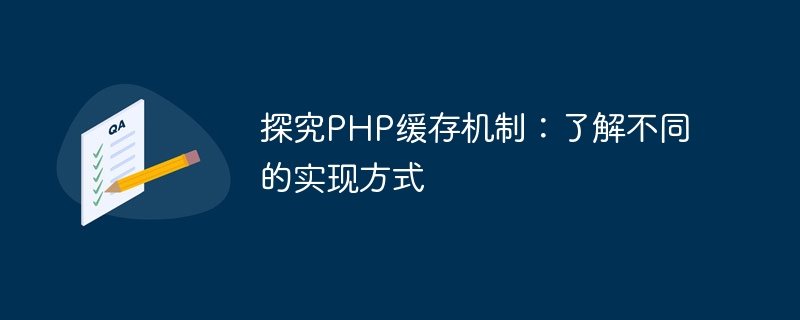Home >Backend Development >PHP Tutorial >Understanding PHP caching mechanisms: exploring different implementations

Exploring the PHP caching mechanism: To understand different implementation methods, specific code examples are required
The caching mechanism is a very important part in web development and can greatly improve the website performance and responsiveness. As a popular server-side language, PHP also provides a variety of caching mechanisms to optimize performance. This article will explore PHP's caching mechanism, introduce different implementation methods, and provide specific code examples.
function getDataFromCache($cacheKey, $cacheTime) {
$cacheFile = 'cache/' . $cacheKey . '.txt';
// 检查缓存文件是否存在并且未过期
if (file_exists($cacheFile) && (filemtime($cacheFile) + $cacheTime) > time()) {
// 从缓存文件读取数据
$data = file_get_contents($cacheFile);
return unserialize($data);
} else {
// 重新计算数据
$data = calculateData();
// 将数据写入缓存文件
file_put_contents($cacheFile, serialize($data));
return $data;
}
}// 创建Memcached对象
$memcached = new Memcached();
$memcached->addServer('localhost', 11211);
function getDataFromCache($cacheKey, $cacheTime) {
global $memcached;
// 尝试从Memcached中获取数据
$data = $memcached->get($cacheKey);
if ($data !== false) {
return $data;
} else {
// 重新计算数据
$data = calculateData();
// 将数据存入Memcached
$memcached->set($cacheKey, $data, $cacheTime);
return $data;
}
}// 开启APC缓存
apc_store('enable_cache', true);
function getDataFromCache($cacheKey, $cacheTime) {
// 检查APC缓存是否开启
if (apc_fetch('enable_cache')) {
// 尝试从APC中获取数据
$data = apc_fetch($cacheKey);
if ($data !== false) {
return $data;
}
}
// 重新计算数据
$data = calculateData();
// 将数据存入APC
apc_store($cacheKey, $data, $cacheTime);
return $data;
}// 创建Redis对象
$redis = new Redis();
$redis->connect('127.0.0.1', 6379);
function getDataFromCache($cacheKey, $cacheTime) {
global $redis;
// 尝试从Redis中获取数据
$data = $redis->get($cacheKey);
if ($data !== false) {
return unserialize($data);
} else {
// 重新计算数据
$data = calculateData();
// 将数据存入Redis
$redis->set($cacheKey, serialize($data));
$redis->expire($cacheKey, $cacheTime);
return $data;
}
}The above are sample codes for several common PHP caching methods. Choosing the appropriate caching method according to the actual situation, and performing corresponding configuration and optimization as needed can effectively improve website performance and response speed. In practical applications, in addition to caching data, database query results, page fragments, etc. can also be cached to further optimize performance.
The above is the detailed content of Understanding PHP caching mechanisms: exploring different implementations. For more information, please follow other related articles on the PHP Chinese website!